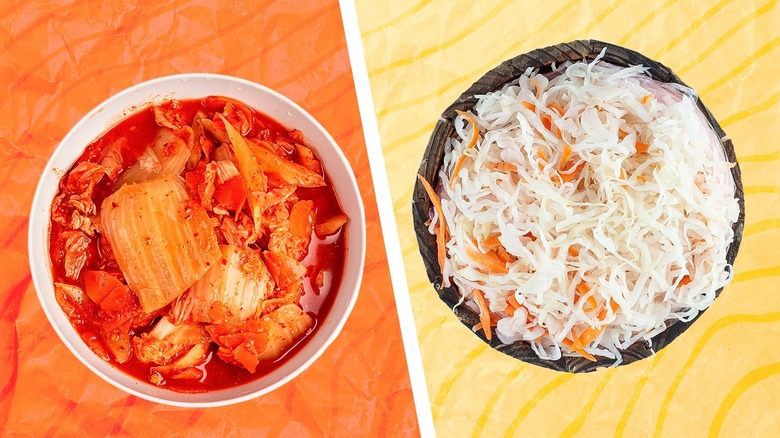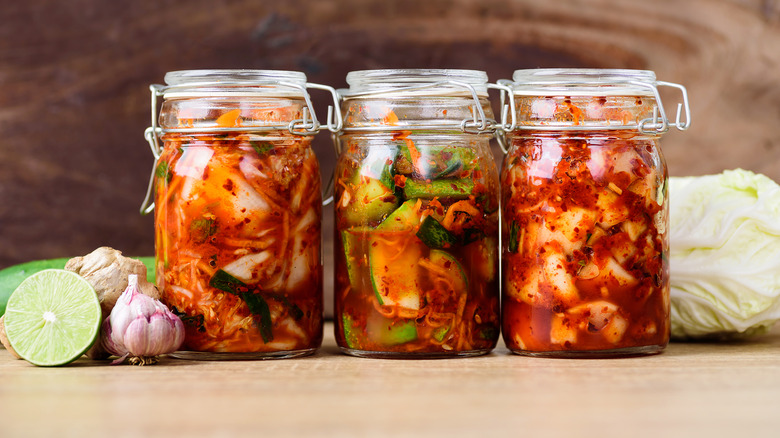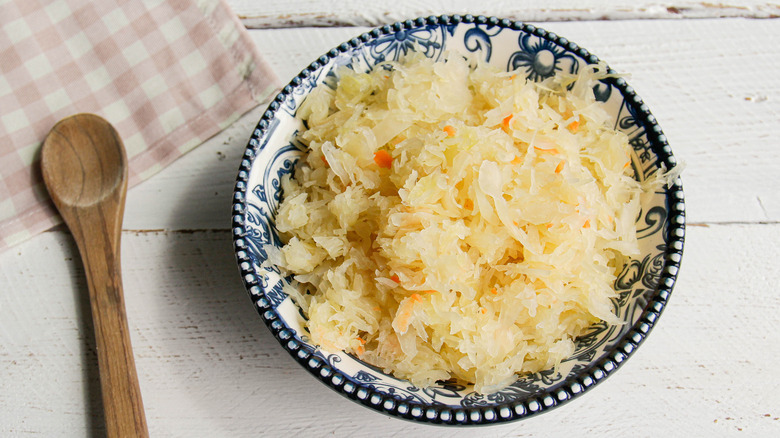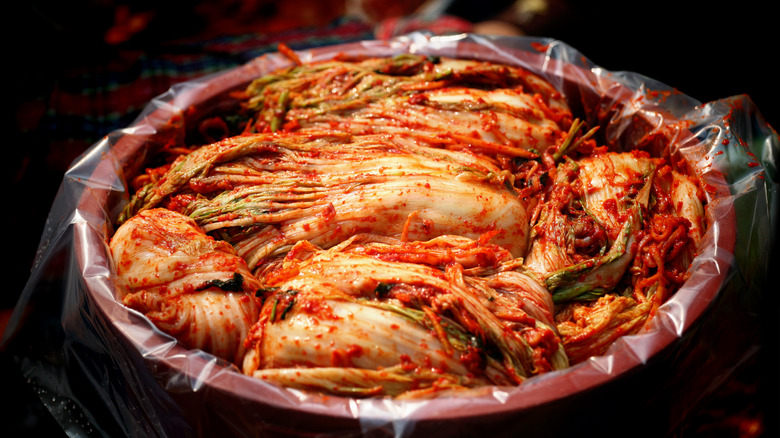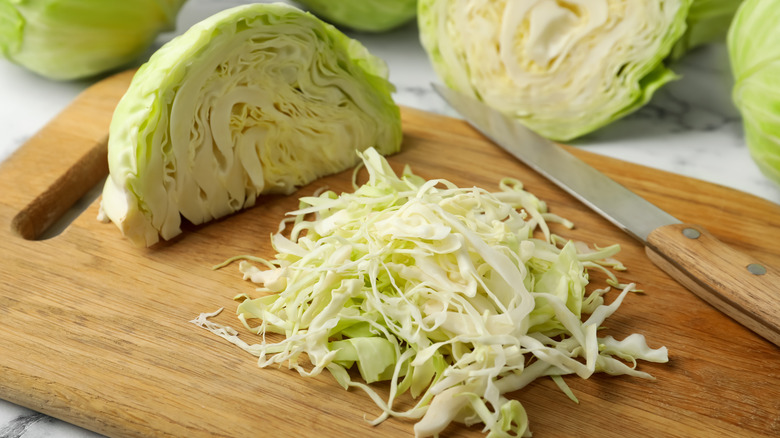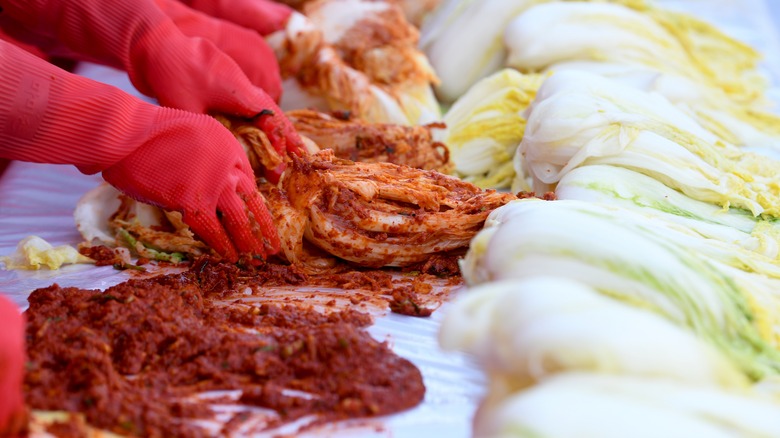The Important Differences Between Kimchi And Sauerkraut
Fermented foods are having a big moment right now, and that means there is no better time to learn what separates two of the most popular options out there: kimchi and sauerkraut. The rise in popularity for fermented foods goes hand-in-hand with the growing attention to things like gut health and microbiomes, but they have been an essential part of the human diet for thousands of years. Not only fermented vegetables but foods like yogurt and miso are integral parts of diets around the globe to this day, and while they may have first been valued for fermentation's ability to preserve food, and then for their health benefits, they also happen to be delicious. Very few foods endure the way that kimchi and sauerkraut have if they don't taste good, after all.
Kimchi and sauerkraut are both fermented vegetable products, but their differences show how similar ideas can diverge across time and cultures. Nobody would see the vibrant color of kimchi or taste its pungent spice and think: This is basically sauerkraut. The variety of umami ingredients that can go into making kimchi varies greatly, whereas sauerkraut maintains a certain austere Eastern European simplicity. But dig a little deeper, and you see similarities too, like how both are used to flavor a huge variety of dishes, from sandwich toppings to roasted meats and hearty soups. They are both real utility players, befitting their shared roles as shelf-stable pantry ingredients.
What is kimchi?
Kimchi is a whole category of Korean pickled vegetables. The most popular and well known is made with cabbage, but there are also varieties made with radish, cucumber, and many other Korean vegetables or combinations of vegetables. The recipes to make kimchi can vary by region and by family, but the most well-known versions are usually flavored with the Korean chili flake gochugaru, fish sauce, garlic, ginger, salt, and scallions. One thing that makes kimchi distinct is that it goes through a three-step process to be produced. The kimchi ingredients are pickled first as they marinate in the flavoring ingredients, then they're fermented. The initial pickling produces lactic acid, which the fermenting stage then multiplies. That one-two punch of preservation techniques gives kimchi its special, pungent flavor.
Kimchi is very popular in Korea and is served with many meals. Because there are over 300 types of kimchi, it's a very versatile product that can be eaten on its own, folded in rice, or added as a flavoring ingredient itself. The wide variety of recipes also means that it's hard to generalize the flavor, but its signature is a mix of sour, salt, fermented funkiness, and hot spice. Both the funk and spice can range from mild to intense depending on the recipe and how long it was aged. Once limited primarily to Korean restaurants and specialty markets in the U.S., kimchi's growing popularity means you can now find at least one kimchi brand in most grocery stores.
What is sauerkraut?
Sauerkraut is a very simple form of fermented cabbage. The name is German and means "sour cabbage." Despite being most commonly associated with Germany, sauerkraut is popular across Eastern Europe, where it goes by different names and is used in all kinds of recipes. Like kimchi, sauerkraut was popularized as a way to preserve vegetables over the winter. Traditionally, sauerkraut was made through dry fermentation using just shredded cabbage and salt. The salt draws out moisture from the cabbage, and the vegetable is left to ferment in its own juices, which can take a few days or several weeks. The natural sugars in the cabbage act as the fermentation agent that gets turned into the preservative lactic acid.
Sauerkraut has a relatively straightforward flavor, but that makes it very versatile as a topping and ingredient. It is salty and sour, but because it is not fermented for very long, it doesn't have the strong funk associated with some fermented foods. Some recipes call for additional spices, but sauerkraut essentially tastes like tangy pickled cabbage. The best known use of sauerkraut is as a condiment for meat, either on sandwiches or alongside chops and roasts where the sharp acidic flavor complements the savory main dish. However sauerkraut can be eaten by itself as a light pickled side, made into salads, or added to soups and stews. It's easy to make at home and is a nice, easy introduction to fermentation, but is also widely available in stores.
Kimchi can be made with a wider variety of seasonings and flavors
Since kimchi is a whole category of fermented foods, the variety of flavors you can experience are much greater than sauerkraut. Even with basic cabbage kimchi, known as baechu kimchi, things like rice flour, sugar, and salted shrimp can be added to augment the taste, along with other vegetables like carrots and radish. Going further away from the most common additions, you may also find kimchi made with fermented soy pastes like doenjang, soy sauce, mushrooms, and mustard greens, which can all add unique notes of flavor.
There is also white kimchi, which refers to versions made without chili flakes. These can include simple kimchis that keep other ingredients the same and just drop the spice, but they may also add things like pear to make the kimchi more sweet. Other popular kimchis that use radish or cucumber will use similar spices and ingredients as baechu kimchi, but the final taste will be affected by the natural sweet taste of the base ingredient.
Sauerkraut is really only made the one way, with minimal additions, so you won't get much variation in flavor. Some versions may add simple aromatics like bay leaves, juniper berries, caraway seeds, or a few spices like garlic powder, but these should only add a little depth. In the end sauerkraut should have the clean taste of its name: sour cabbage.
Sauerkraut is always made with cabbage
It's not just the wide variety of flavorings and additions that separate kimchi from sauerkraut, but also the base ingredients. Sauerkraut is only ever made with cabbage, unlike the many options you have with kimchi. Recipes can use different types of cabbage — red, green, and Napa are all common — but in the end, sauerkraut means cabbage and only cabbage.
Kimchi is a whole world unto itself. We already mentioned popular choices beyond cabbage like radish and cucumber kimchi, but even those alternatives are just the beginning. There are kimchis made from greens (radish greens and mustard greens are just a few), which can be flavored with pungent ingredients like pickled anchovy sauce. You'll also find simple, bright kimchis made from garlic chives and green onions. One of the most unique is perilla leaf kimchi, which uses a versatile herb from the mint family that is popular in Korea and has notes of anise.
Kimchi even includes some styles that are meals by themselves. Water kimchi like nabak and dongchimi feature a mix of sliced vegetables in fermented broths flavored with ingredients like pear juice, ginger, and pepper. Finally, you have bossam, or wrapped kimchi, where an array of fillings from fish, oysters, or shrimp, to mushrooms, chestnuts, mustard leaf, and pear are wrapped in wilted cabbage and fermented. You may think of cabbage kimchi first, but it's only the beginning.
Both kimchi and sauerkraut originated in Asia
Given kimchi's status as one of Korea's national foods, its origins aren't much of a surprise. Written records of kimchi in Korea date back almost a thousand years to 1145 A.D., but other sources suggest it could be up to 4,000 years old. Korea's harsh winters necessitated ways to preserve food, but Korea lacked the oils used to preserve food in warmer neighboring regions like China. Instead, they opted to use fermentation by packing salted vegetables in earthen pots and burying them underground. The long storage times first introduced the Korean people to the new flavors that developed and the potential of fermented vegetables, and they have been a comfort staple of the cuisine for ages.
Sauerkraut has a harder history to trace, but the version we enjoy today appears to have originated in China, not Germany or Eastern Europe. There are records showing that the Romans enjoyed fermented cabbage and valued its healthy properties, but at some point, their sauerkraut tradition was lost. Around the same time, Chinese laborers building the Great Wall were preserving cabbage in rice wine for the winter. That version was carried by the Tartars to Europe during their conquests in the 13th century. It was during that transmission that the recipe went from being made with vinegar to the salting method used in Europe today.
Kimchi and sauerkraut are both great for your gut
Sauerkraut and kimchi both have long standing reputations as healthy food in their home regions, and science actually backs that up. In Europe eating sauerkraut has been associated with health and longevity, and Korean families see kimchi as a healthy mix of vegetables and the probiotic properties of yogurt. The cabbage and vegetables used in both dishes are full of vitamins and nutrients, but the real star is the process of lacto-fermentation that takes place. Just like in yogurt, that fermentation produces probiotics, which are live microorganisms that help your body run.
The probiotics in kimchi and sauerkraut can provide your gut microbiome with live, beneficial microbes, helping keep it healthy and balanced. A healthy gut helps not just with digestion and absorption of nutrients but is also linked to a stronger immune system and reduced inflammation. Your gut microbiome even interacts with your brain, and a healthy digestive system can improve your mood, reduce mental fatigue, and help your metabolism. Probiotics can even help fight off bad bacteria, viruses, and parasites. It's no wonder fermented cabbage has been recommended by grandmothers for centuries. Just make sure that you are buying kimchi and sauerkraut with live cultures for the full potential health benefits.
Sauerkraut is best as a condiment, while kimchi has many possible uses
The number one way to use sauerkraut is as a topping for meat and sandwiches, especially hot dogs and sausages but also on a reuben or ham sandwich. As a side, the classic pairing is with roast pork, but sauerkraut is also eaten with latkes and potato pancakes, sausages sans buns, and in Eastern Europe, it is served alongside pierogis. One traditional dish that is centered around sauerkraut instead of using it on the side is tangy sauerkraut soup. It's also used as a flavoring in some casseroles. But whether as a side or topping, sauerkraut is usually complementary.
Kimchi is most commonly enjoyed as a side dish along with other complementary Korean sides known as banchan, but it has almost endless possibilities. It can top rice for a simple meal or be used to flavor stir-fries and noodles. Like sauerkraut, it gets turned into a stew as well, the Korean dish kimchi jjigae, and gets used as a filling for dumplings. Another great Korean dish that turns kimchi into a full meal is kimchijeon, a simple crispy pancake that can be eaten with a dipping sauce. But don't be limited by traditional recipes: Kimchi makes a great burger topping and it livens up grilled cheese with its spicy tang. A jar of kimchi really will be one of the most versatile additions to your kitchen, and keeping one is a great invitation to experimentation.
